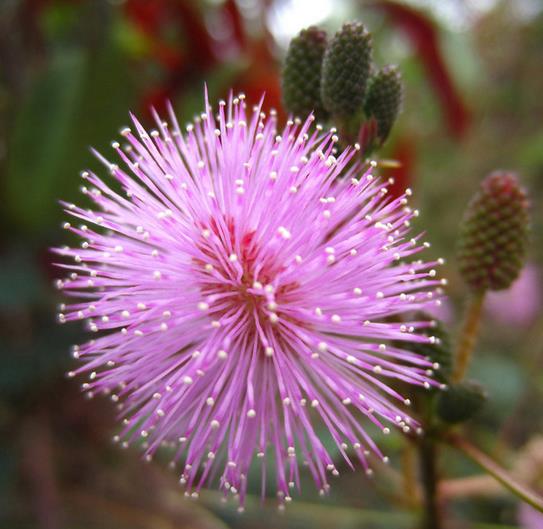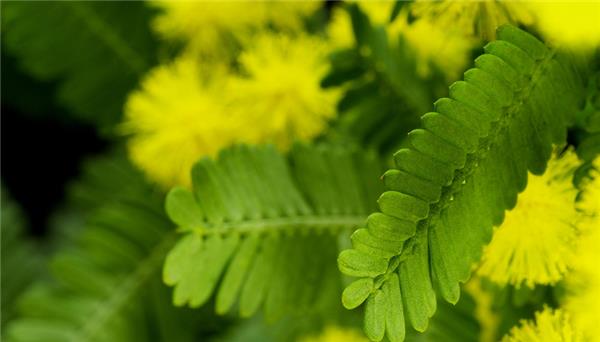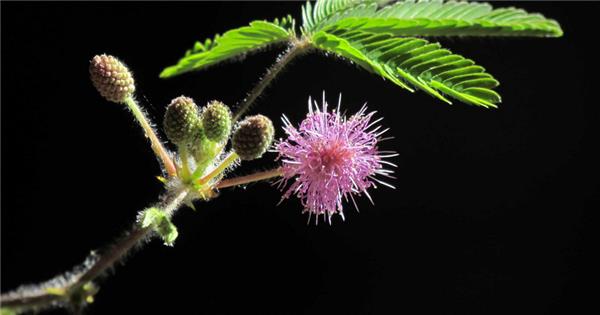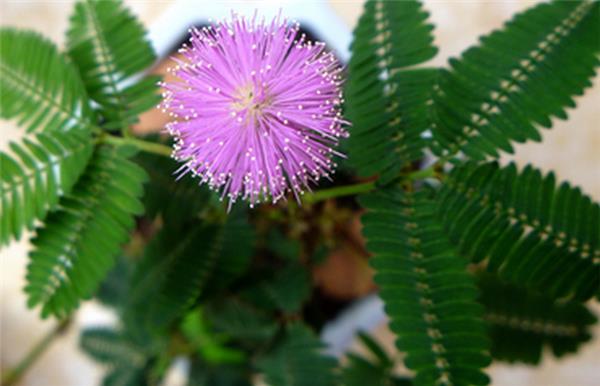Introduction and culture methods of shy small plant mimosa
Mimosa is an interesting plant, which is different from other plants. When touched by the outside world, the petiole is drooping and the small leaves are closed, which is understood as "shyness". Let's take a look at the knowledge of mimosa.

I. introduction of mimosa
Mimosa is a perennial herb or subshrub of Leguminosae, which is named mimosa because its leaves respond to heat and light and close immediately when touched by external forces. Native to tropical South America, it likes to be warm and humid, and is not strict with the soil. The flower is pink, shaped like a fluffy ball, delightful. Pods bear fruit after flowering, and the fruit is flat and round. The leaves are feathery and compound leaves are alternate and arranged in palms. The flowers, leaves and pods of mimosa have better ornamental effect, and are easy to survive, so they are suitable for balcony, indoor potted flowers, and can also be planted in the courtyard.

2. Cultivation techniques of mimosa
1. Cultivation and planting
General soil can be cultivated, the growth period does not need much fertilizer, dilute liquid fertilizer can be applied for 2 or 3 times, fertilizer should not be too much, leaf green can grow healthily, do not grow in vain, because mimosa is mainly interesting foliage flowers, small is better. The planting technique of mimosa is simple and the management is extensive. The requirements of climate, sunshine and soil are not strict, but the fertile, loose sandy loam is better, like the warm and humid environment. Planting method. Generally sow and reproduce, and sow from late March to early April. Spread the seeds evenly on the fine soil and cover the soil for about 1.5m. When the temperature is about 18 ℃, the seedlings can emerge in about 10 days (generally grow in the soil, no special management is needed). It grows slowly in seedling stage and can be planted when it is 7 ~ 8 years old.
two。 Field management
The distance between plants in the field is 25 to 30 meters, and the soil is loosened, weeded and watered in time. Indoor potted plants, watered once every 2 to 3 days in summer.
3. Key points of maintenance
During the growth period of mimosa, it can be combined with watering and apply rotten dilute liquid fertilizer (3-4) every 10 days or so. As a potted ornamental flower, it is easy to move into the sunny place indoors and can survive the winter safely at a room temperature of 0: 12 degrees.
Moisture: like to be moist, watered once a day during the summer growth period. Fertilizer: topdressing is applied once every half month at seedling stage. If you do not want the plant to be too large, you should reduce the amount of fertilizer applied.
Soil: the soil should be deep, fertile and moist.
Temperature: not cold-resistant, like warm climate, plants die by themselves in winter.
Light: full of happy light, slightly resistant to half-shade.
Reproduction: sowing and reproduction. When the seeds were sown from late March to early April, the growth was slow in the seedling stage, and it could be planted when the seedling height was 7 to 8 meters.

Third, the function and use of mimosa
1. Decorative application
Mimosa plants are scattered, the feather leaves are slender and beautiful, and their leaves are closed as soon as they touch, giving people the impression of being weak and elegant. The ground is scattered in the corner of the courtyard. Potted plants can be placed on the window table.
two。 Ornamental value
Mimosa plant shape scattered, feather leaves slender and beautiful, its leaves are closed at a touch; mimosa flowers are many and beautiful, charming, giving people the impression of weak and elegant. It can be planted in the corner of the courtyard or potted in the window. When giving flowers, gently cover the potted plants with pink tulle and tie them with pink ribbons and knots. It would be more interesting if you could adorn it with pink mohair balls.
3. Forecast the weather
Mimosa is a wonderful plant that can predict changes in the weather. If you touch it with your hand, its leaves close quickly and open slowly, indicating that the weather will clear up; if you touch mimosa, its leaves contract slowly, droop slowly, or even reopen a little bit, this means that the weather will change from sunny to overcast or it is going to rain. The reason why the opening and closing speed of mimosa leaves can foretell the weather is mainly due to the fact that in the neck of mimosa leaves, there is a small drum-shaped parenchyma tissue-leaf mattress, which is filled with water. When you touch the mimosa leaf with your hand, as soon as the leaf vibrates, the water in the lower cells of the leaf mattress immediately flows upward to both sides, so that the lower part of the leaf mattress shrivels down, while the upper part bulges up, the petiole droops and the leaf closes. Therefore, the closure and opening of leaves are caused by the swelling and pressure of leaf mattresses. The expansion and pressure of the leaf mattress is closely related to the humidity in the air. When the air humidity is very small, the expansion and pressure effect of the leaf mattress is obvious, and the closing and opening speed of the leaf is fast; when the air humidity is very high, the opening and closing speed of the leaf is slow. Therefore, the speed of opening and closing of mimosa leaves indirectly reflects the humidity in the air and can be used as a reference for weather forecast.

4. Earthquake prediction
According to Turkish seismologist Erjiang, a few hours before a strong earthquake, the leaves of mimosa, which are sensitive to the outside world, suddenly shrink and then wither. In earthquake-prone Japan, scientists have found that under normal circumstances, mimosa leaves open during the day and close at night. If the leaves of mimosa close during the day and open at night, it is a sign of an earthquake. For example, at 7: 00 a.m. on January 11, 1938, the mimosa began to open, but at 10:00, all the leaves suddenly closed, and sure enough, a strong earthquake occurred on the 13th. Members of the earthquake Club of Japan in 1976 observed the abnormal closure of mimosa leaves many times, resulting in an earthquake. This is a real event! In addition, mimosa can also predict disastrous weather changes, which will produce unconventional growth activities to sudden anti-seasonal temperature difference, geomagnetism, geoelectricity and other changes. We can put some potted mimosa plants in the room to observe the prediction and prevention of natural disasters.
The above is the knowledge of mimosa, I hope I can help you.
4. Earthquake prediction
According to Turkish seismologist Erjiang, a few hours before a strong earthquake, the leaves of mimosa, which are sensitive to the outside world, suddenly shrink and then wither. In earthquake-prone Japan, scientists have found that under normal circumstances, mimosa leaves open during the day and close at night. If the leaves of mimosa close during the day and open at night, it is a sign of an earthquake. For example, at 7: 00 a.m. on January 11, 1938, the mimosa began to open, but at 10:00, all the leaves suddenly closed, and sure enough, a strong earthquake occurred on the 13th. Members of the earthquake Club of Japan in 1976 observed the abnormal closure of mimosa leaves many times, resulting in an earthquake. This is a real event! In addition, mimosa can also predict disastrous weather changes, which will produce unconventional growth activities to sudden anti-seasonal temperature difference, geomagnetism, geoelectricity and other changes. We can put some potted mimosa plants in the room to observe the prediction and prevention of natural disasters.
The above is the knowledge of mimosa, I hope I can help you.
- Prev

Introduction and cultivation skills of bowl lotus how to cultivate graceful bowl lotus
Introduction and cultivation skills of bowl lotus how to cultivate graceful bowl lotus
- Next

Introduction and culture method of plant tortoise shell with tortoise shell
Introduction and culture method of plant tortoise shell with tortoise shell
Related
- Wuhan Hospital Iron Tree Blooming Result Was Instantly Frightened by the Gardener Master
- Which variety of camellia is the most fragrant and best? Which one do you like best?
- What is the small blue coat, the breeding methods and matters needing attention of the succulent plant
- Dormancy time and maintenance management of succulent plants during dormancy
- Minas succulent how to raise, Minas succulent plant pictures
- What are the varieties of winter succulent plants
- How to raise succulent plants in twelve rolls? let's take a look at some experience of breeding twelve rolls.
- Attention should be paid to water control for succulent plants during dormant period (winter and summer)
- Watering experience of twelve rolls of succulent plants
- Techniques for fertilizing succulent plants. An article will let you know how to fertilize succulent plants.

